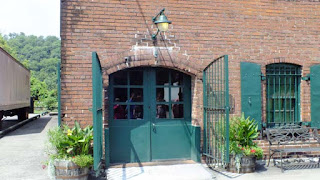Our first tour was in Georgetown which was at the Georgetown Toyota Motor Manufacturing Kentucky Plant which was the first wholly owned manufacturing plant in the United States. The first car off the line in 1988 here was the Camry which now sits in the Visitor Center with 94 miles on it. This plant is the largest plant outside of Japan and employs 7,000 who work in two shifts a day. 2,000 Camry, Avalon and Venza cars roll off the assembly line each day with a total of 500,000 cars per year. Wow!
At the Visitor Center there are hands on and visual displays. Here too begins a tram tour of the 94 million square foot facility which takes about an hour. Our first stop was to watch a short video recounting the history of Toyota in Georgetown then riding on a narrated tram tour through stamping, body welding , plastics and assembly areas. The facility has its own health department, gym and several cafeteria, day care and preschool facilities. All employees take their breaks and lunch hour at the same time so assembly is stopped during that time. We also learned that after each break, employees on a team doing a certain process change to doing some other process within that teams job descriptions thus helping employees to not get bored or tired doing the same process. It also helps with their overall health on the job. Ron tells me that Presbyterian where he work as well as many other companies follow Toyota's management and inventory processes which were outlined for us today. No pictures were allowed. We could not even bring in purses, back packs or any kind of electronic device. These had to be left in your car.
After leaving Toyota, we headed 20 miles down the road to Frankfort where we took a walking tour of the Buffalo Trace Distillery, the most award winning Distillery which has been producing bourbon since 1787 and proudly holds the title of the oldest continually operating Distillery in American even open during Prohibition for "medicinal" purposes . The facility is a National Historic Landmark, next to the Kentucky River, stands on 130 acres in the heart of Kentucky with five centuries of architecture represented and has numerous old red brick multi level buildings where the oak barrels filled with bourbon are aged.
Our tour began in the Visitor Center and proceeded across the complex to an old building where we watched a video about the history, heritage and fine Kentucky bourbon.
Our tour included walking in a century-old aging warehouse,
\
learning about the different stages of the bourbon-making process and the hand bottling of premium bourbon. Back at the quaint Visitor Center we are offered a free sampling of two Buffalo Trace Kentucky Straight Bourbon Whiskey produced on site in a tasting room filled with old pictures of the distillery. Since Ron and I drink very little in the way of hard liquor, we really didn't know what was different or the same about either of the ones we tasted. All I know is that I really don't like straight liquor much. We enjoy wine and beer more.
We also were offered a sample of Bourbon Cream and advised to mix it with some offered root beer. In addition, we sampled some Chocolate Bourbon Balls. Yum! Yum!
We came away with several bits of knowledge about bourbon. There are two kinds produced - one with corn, rye and malt mash and another made with corn, wheat and malt mash each producing a different taste. Bourbon has to be produced with a minimum of 51% corn while bourbon produced with more corn being sweeter. Bourbon made with rye is spicier than that made with wheat. The barrels are aged in multi storied brick buildings with barrels on different floors producing different flavors due to the different temperatures found on each floor. The one time use oak barrels used for the aging process are sold to micro breweries, some to individuals for planters and decorative items and others to distilleries to make other kinds of whiskey. The facility also includes a gift shop along with its tasting room. Now you know more than you ever wanted to know about bourbon.
What an interesting day we had.
.








No comments:
Post a Comment